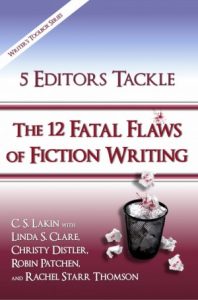4 Key Ways to Improve Tension and Pacing in Your Novel
Pacing and tension aren’t always easy for writers to assess in their scenes. How can you tell if your scene is dragging and there is little tension? How do you know when to speed up or slow down pacing for best effect?
Let’s bring it all together in four key points, from a previous post and excerpt from The Fatal Flaws of Fiction Writing.
Don’t Forget the Conflict . . .
Inner and outer conflict. First, overall, you want your pages full to the brim with conflict. Meaningful conflict. Showing a character fussing for a full page about her lousy manicure isn’t all that meaningful.
Now, that situation could be the center of a really hilarious comedic moment, and if so, terrific. Humor—great humor—is so often overlooked, and it ramps up pacing and engages readers. But not all novels are full of funny moments.
Conflict is tension. Meaningful conflict creates strong tension. Hemingway said, “Don’t mistake movement for action.” Just because you have a lot of things happening, plot-wise, doesn’t mean anything is really happening. You could have tons of exciting car chases and plane crashes and shoot-outs and the reader could be dozing off, nose planting into your book.
So be sure to provide meaningful inner and outer conflict everywhere you can. The more you can complicate your characters’ lives, the more potential tension
. . . Or the Compelling Characters
Engaging characters. If I’ve said this once, I’ve said it a thousand times: if readers don’t care about your characters, if they don’t care what happens to them, they are not going to feel that tension. We want our readers tense. Worried, concerned, glued to the page, anxious to know what happens next. They aren’t going to feel that tension unless you do the hard preliminary work of developing and then bringing to life from the get-go those empathetic, unique, compelling characters.
Yes, you may have a great plot. An exciting, riveting, original plot. But if your characters are boring, uninteresting, mundane, annoying, lacking passion or skills or interest in something, anything, all the great plot twists in the world won’t create tension.
If you can take home one key bit of info about tension and pacing, make it this one.
Boring, Boring
Don’t bog your scenes down with a lot of boring stuff. What’s boring? Anything that isn’t interesting. I shouldn’t have to spell this out, right? When you read a novel and you find yourself drifting off, thinking about what to make for dinner, skimming over pages that you later realize you might have read but can’t remember, you know you just hit a boring patch.
This can be applied to both macro and micro issues. You don’t want boring scenes—characters sitting around in dull, uninteresting settings. That includes the overused scenes in Starbucks or restaurants, with characters just talking and drinking coffee.
Make Sure Every Scene Has a Point
Every scene needs to have a clear, important purpose in advancing and/or complicating your plot. Making it harder for your protagonist to reach her goal. Usually the reason so many scenes in first novels lack tension and pacing is there’s nothing happening (and it’s going nowhere).
Go through your WIP (work in progress). Ditch every scene in which nothing is happening. Or rework so that something significant is happening. I can’t emphasize enough how important a scene outline is.
I can guarantee you: if you make sure every scene is important to your story and serves to advance the plot, you will find your pacing and tension ramping up.
Scrutinize Your Writing
On the micro level, look at your writing. Most of the novels I edit and critique are stuffed with extraneous words that drag. Pretend that each word has some intrinsic weight and that your readers are carrying your scenes up a steep hill. The heavier the sack of words they are carrying, the harder the struggle to make it to the peak.
If I were climbing that hill and the sack was too heavy, I’d stop, sit, and dump the contents out on the ground. Then I’d pick through all those words and toss out as many as I could that I really don’t need. Often you can throw out four in exchange for one good word.
Make every word count. Your reader will climb to the climax of your story with a lighter, happier step.
Don’t Write Like Everyone (or Anyone) Else
Spend time developing a trademark writing style. Maybe you hadn’t considered that this could affect pacing and tension, but it does. This ties back in with “boring.” If you use unimaginative words, phrases, descriptions, or narrative, you have to work all that much harder to keep your reader’s interest. Your plot, characters, and other novel components will have to carry the entire weight of the tension and pacing.
In contrast, you can often have very little happening in the way of plot. And yes, I’ll go so far as to say: you could even have that boring scene in that boring restaurant turn into a riveting, page-turning tense experience for your reader if your writing is spectacular. What I mean by that is your prose is beautiful; your word choice is fresh and surprising; your concepts and abstracts are imaginative and wholly new; your metaphors, motifs, symbolism, and similes are moving and thought-provoking.
No, it’s not likely you are going to wow your reader with every line, but why not aim for every page to convey a firm grasp of the creative use of language? Make it your aim to be a fine wordsmith, to craft beautiful sentences the way a sculptor or painter handles marble or paint. The blank page is your canvas, and the words you write and subsequently publish showcase your talent and creativity to the world. Don’t paint boring word pictures when you could do oh-so-much more than just slap words onto the page without careful thought.
Strong Pacing Does Not Mean Light Speed
One last comment about pacing. Having a strong pace throughout your book doesn’t mean keeping everything moving at light speed. Don’t confuse pacing with speed. You need to have slow, reflective moments with your characters. Novels are a cycle of action-reaction-action-reaction. Things happen, characters react, process, make decisions (act), then more things happen.
You might think that in those reflective moments the pace has slowed down. The car chase is over, and now the hero is sitting in a chair in the hospital looking at the woman he loves, who is in a coma. Sure, the action has slowed down. Remember Hemingway: movement doesn’t mean action. Similarly, lack of movement doesn’t mean lack of action. A poignant, heavy emotional scene in which there is little action can be as tense or even much tenser than that high-speed car chase.
Why? Because you’ve gotten your readers emotionally invested in your characters. Make sense?
Your thoughts? What do you feel is key to strong pacing? Share in the comments!
 Don’t fall victim to the fatal flaws of fiction writing.
Don’t fall victim to the fatal flaws of fiction writing.
This extensive resource is like no other! With more than sixty before and after passages, we five editors show writers how to seek and destroy these flaws that can infest and ruin your writing.
Here are some of the 12 fatal flaws:
- Overwriting—the most egregious and common flaw in fiction writing.
- Nothin’ Happenin’—Too many stories take too long to get going. Learn what it means to start in medias res.
- Weak Construction—It sneaks in at the level of words and sentences, and rears up in up in the form of passive voice, ing verbs, and misplaced modifiers.
- Too Much Backstory—the bane of many manuscripts. Backstory has its place, but too often it serves as an info dump and bogs down pacing.
- POV Violations—Head hopping, characters knowing things they can’t know, and foreshadowing are just some of the many POV violations explored.
- Telling instead of Showing—Writers have heard this admonition, but there’s a lot to understanding how and when to show instead of tell.
- Lack of Pacing and Tension—Many factors affect pacing and tension: clunky passages, mundane dialogue, unimportant information, and so much more.
- Flawed Dialogue Construction—Writers need to learn to balance speech and narrative tags and avoid “on the nose” speech.
- “Underwriting”—just as fatal as overwriting. Too often scenes are lacking the necessary actions, descriptions, and details needed to bring them to life.
- Description Deficiencies and Excesses—Learning how to balance description is challenging, and writers need to choose wisely just what to describe and in what way.
Don’t be left in the dark. Learn what causes these flaws and apply the fixes in your own stories.
No one need suffer novel failure. You don’t have to be brilliant or talented to write strong fiction. You just need to be forewarned and forearmed to be able to tackle these culprits. And this book will give you all the weapons and knowledge you need.
“This book should be on every writer’s bookshelf.” —Cheryl Kaye Tardif, international best-selling author











Very good advice, thanks. Personally I think that the characters who are on stage at any one time must have in some sense conflicting agendas, they must be trying to achieve mutually incompatible ends. This can be as simple as one character trying to get vital information and another trying to conceal it, or as critical as a full-scale fight to the death in a doomed spaceship.
Romance itself can be a form of conflict where two people have very different ideas about where they want the relationship to go. Of course the problem here is to work this in without headhopping. At the end of one chapter I have:
Arcturian. The very word had a resonance to it, redolent of the afternoon that his mother had first taken him to the spaceport. He’d spelled out the words ARCTURIAN INTERSTELLAR in glossy green capitals on the dull silver of a parked liner and asked what they meant—but he’d found more questions than answers. Arcturian—that word stood in his mind for all that was mysterious and powerful. It was Camelot and Xanadu and Numenor all rolled into one.
Now it was Jane as well, the girl he’d shared supper with, the same Jane that had taught him to dance Farmer’s Daughter. She was an Arcturian, she was a part of the great mystery.
And that knowledge only added to her attraction. He wondered if, for the first time in his life, he might be falling in love.
Then in the next but one chapter (Jane is at the controls of the spaceship):
‘It’s beautiful.’ He paused, eyes widening. ‘What are we looking at? If we’re going faster than light how can we see anything at all?’
Jane shook her head. ‘We are behind the walls of the universe now, looking at space from the back, that’s the only way I can describe it.’
Slowly, while she’d been talking, Jane’s hand had slid across the throttle pedestal, and was now holding Alan’s.
So it was that they flew on, hand in hand, through the mystic, golden beauty that is orthospace, while Jane tried with all her might to convince herself that she was doing nothing wrong. She couldn’t possibly hurt him, could she? Not unless he did something really silly like falling in love with her. And he was hardly likely to do that.
That misunderstanding in the end gets Alan killed, something for which Jane blames herself. Coming to terms with this in the end makes Jane stronger, and that strength is what she needs to take on the villain in the next book.
Thanks again. Very thought-provoking post.
Great concise information here. Thanks! I’ve shared it online. All best to you!